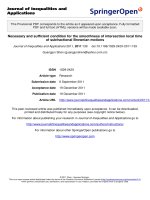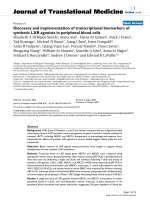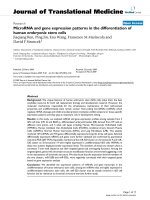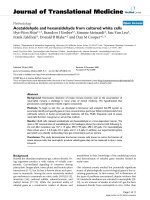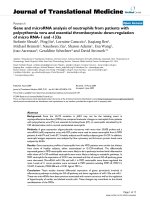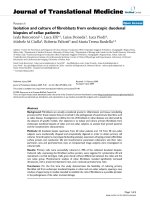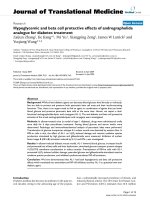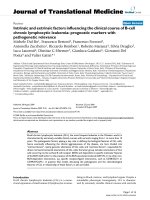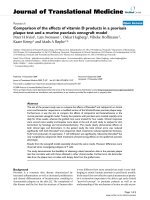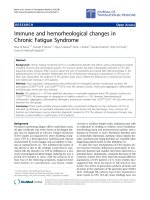báo cáo hóa học: " Presence and rehabilitation: toward second-generation virtual reality applications in neuropsychology" pdf
Bạn đang xem bản rút gọn của tài liệu. Xem và tải ngay bản đầy đủ của tài liệu tại đây (314.42 KB, 11 trang )
BioMed Central
Page 1 of 11
(page number not for citation purposes)
Journal of NeuroEngineering and
Rehabilitation
Open Access
Review
Presence and rehabilitation: toward second-generation virtual
reality applications in neuropsychology
Giuseppe Riva*
1,2
, Fabrizia Mantovani
1,3
and Andrea Gaggioli
1,4
Address:
1
Applied Technology for Neuro-Psychology Lab., Istituto Auxologico Italiano, Milan, Italy,
2
Department of Psychology, Catholic
University of Milan, Milan, Italy,
3
Department of Epistemology and Hermeneutics of Education, University of Milan-Bicocca, Milan, Italy and
4
Psychology Lab., Department of Preclinic Sciences LITA VIALBA, State University of Milan, Milan, Italy
Email: Giuseppe Riva* - ; Fabrizia Mantovani - ;
Andrea Gaggioli -
* Corresponding author
Abstract
Virtual Reality (VR) offers a blend of attractive attributes for rehabilitation. The most exploited is
its ability to create a 3D simulation of reality that can be explored by patients under the supervision
of a therapist. In fact, VR can be defined as an advanced communication interface based on
interactive 3D visualization, able to collect and integrate different inputs and data sets in a single
real-like experience.
However, "treatment is not just fixing what is broken; it is nurturing what is best" (Seligman &
Csikszentmihalyi). For rehabilitators, this statement supports the growing interest in the influence
of positive psychological state on objective health care outcomes.
This paper introduces a bio-cultural theory of presence linking the state of optimal experience
defined as "flow" to a virtual reality experience. This suggests the possibility of using VR for a new
breed of rehabilitative applications focused on a strategy defined as transformation of flow. In this
view, VR can be used to trigger a broad empowerment process within the flow experience induced
by a high sense of presence.
The link between its experiential and simulative capabilities may transform VR into the ultimate
rehabilitative device. Nevertheless, further research is required to explore more in depth the link
between cognitive processes, motor activities, presence and flow.
Introduction
What is virtual reality (VR)? For many health care profes-
sionals, VR is first of all a technology. Since 1986, when
Jaron Lamier used the term for the first time, VR has been
usually described as a collection of technological devices:
a computer capable of interactive 3D visualization, a
head-mounted display and data gloves equipped with one
or more position trackers.
But is this definition enough to describe the potential of
VR for rehabilitation? If we look at its actual applications
in rehabilitation, the answer is probably not [1].
VR can be considered the leading edge of a general evolu-
tion of present communication interfaces like television,
computer and telephone [2]. The main characteristic of
this evolution is the full immersion of the human senso-
Published: 08 December 2004
Journal of NeuroEngineering and Rehabilitation 2004, 1:9 doi:10.1186/1743-0003-1-9
Received: 26 November 2004
Accepted: 08 December 2004
This article is available from: />© 2004 Riva et al; licensee BioMed Central Ltd.
This is an Open Access article distributed under the terms of the Creative Commons Attribution License ( />),
which permits unrestricted use, distribution, and reproduction in any medium, provided the original work is properly cited.
Journal of NeuroEngineering and Rehabilitation 2004, 1:9 />Page 2 of 11
(page number not for citation purposes)
rimotor channels into a vivid and global communication
experience [3].
In fact, VR is used in rehabilitation as "an advanced form
of human-computer interface that allows the user to inter-
act with and become immersed in a computer-generated
environment in a naturalistic fashion" [4].
Following this vision Rizzo et al. [5] identify twelve assets
that are available with VR for neuropsychological applica-
tions:
• The capacity to systematically deliver and control
dynamic, interactive 3D stimuli within an immersive
environment that would be difficult to present using other
means.
• The capacity to create more ecologically valid assessment
and rehabilitation scenarios.
• The delivery of immediate performance feedbacks in a
variety of forms and sensory modalities.
• The provision of "cueing" stimuli or visualization tactics
designed to help guide successful performance to support
an error-free learning approach.
• The capacity for complete performance capture and the
availability of a more naturalistic/intuitive performance
record for review and analysis.
• The capacity to pause assessment, treatment and train-
ing for discussion and/or integration of other methods.
• The design of safe testing and training environments
that minimize the risks due to errors.
• The capacity to improve availability of assessment and
rehabilitation by persons with sensorimotor impairments
via the use of adapted interface devices and tailored sen-
sory modality presentations built into VE scenario design.
• The introduction of "gaming" features into VR rehabili-
tation scenarios as a means to enhance motivation.
• The integration of virtual human representations (ava-
tars) for systematic applications addressing social interac-
tion.
• The potential availability of low cost libraries of VEs that
could be easily accessed by professionals.
• The option for self-guided independent testing and
training by clients when deemed appropriate.
In summary, VR provides a new human-computer interac-
tion paradigm in which users are no longer simply exter-
nal observers of images on a computer screen but are
active participants within a computer-generated three-
dimensional virtual world [6-8]: in the virtual environ-
ment (VE) the patient has the possibility of learning to
manage a problematic situation related to his/her distur-
bance in a functionally relevant, ecologically valid experi-
ence [9,10].
This outline better clarifies the possible role of VR in reha-
bilitation: a communication interface based on interactive
3D visualization, able to collect and integrate different
inputs and data sets in a single real-like experience [2,11].
This is possible because the key characteristic of VR, differ-
entiating it from other media or communication systems,
is the sense of presence [12], usually defined as the "sense
of being there" [13], or the "feeling of being in a world
that exists outside the self" [14].
This feeling is theorized to contribute to the efficacy of VR
as rehabilitation tool: the successful use of VR exposure
therapy for phobias [15-18], postraumatic stress disorders
[19-21], and the pain reduction obtained in burn patients
during a VR session [22-25] underline the possible role
that an high level of presence, elicited by the VR experi-
ence, may have in the rehabilitation process.
Thanks to presence, not only knowledge acquisition is
possible in VR, but also this acquired knowledge can be
transferred in a real environment [26,27]. This, evidence,
coming also from different neuropsychological studies
[1], adds value on VR use in the rehabilitation of highly
social disabling cognitive functions, highlighting how
goals reached in controlled settings may be transferred on
patients' everyday life.
Now, the challenge within this area is the creation of new
paradigms [28]. As clearly underlined by Morganti [1]
"More than a playing tool supporting cognitive or motor
performances VR simulation has to provide a powerful
chance to build personal meaning, map and strategies
interacting with it."
Within this context we propose to investigate the impact
of VR on rehabilitation and subjective experience from a
theoretical perspective that stresses the active role of indi-
viduals in interacting with their natural and cultural envi-
ronment [29,30]. In this process a key role is played by the
concept of "presence" and its link with our optimal expe-
riences.
Journal of NeuroEngineering and Rehabilitation 2004, 1:9 />Page 3 of 11
(page number not for citation purposes)
A bio-cultural theory of presence
Presence as separation between "external" and "internal"
What is presence? Answering to this question is not a sim-
ple task [12,31,32]. In fact, if we check the present status
of presence research, we can find two different but coexist-
ing visions.
A first group of researchers describes the sense of presence
as a function of our experience of a given medium [33-
41]. The main result of this approach is the definition of
presence as the perceptual illusion of non-mediation [37],
produced by means of the disappearance of the medium
or its transformation into a social entity. Following this
vision the experience of presence is only related to our
interaction with an external artifact. The main advantage
of this approach is its predictive value: the level of pres-
ence is reduced by the experience of mediation during the
interaction.
This approach, however, does not address some broader
questions: What is presence for? Is it a specific cognitive
process? What is its role in our daily experience?
To answer these questions a second group of researchers
considers presence as a neuropsychological phenomenon,
evolved from the interplay of our biological and cultural
inheritance, whose goal is the control of agency [2,12,42-
49].
Within this paper, we will support the second vision, try-
ing to link it with the outcome of the first one [50]. Here,
presence is delineated as an evolved bio-cultural internal
selection mechanism that helps the self in organizing the
streams of sensory data: the more it can differentiate the
self from the external world, the more is our experience of
presence. The main goal of this differentiation is the con-
trol of agency to improve the possibility of survival within
the external environment.
To fully understand the key ideas behind this vision, three
points are critical:
– Presence has a simple but relevant role in our everyday
experience: the control of agency through the uncon-
scious separation of "internal" and "external". The mean-
ing of "internal" and "external" is not related only to the
body but also to the social and cultural space (situation)
in which the self is in;
– The presence-as-process (the separation mechanism)
produces, but it is different from the presence-as-feeling
(the experienced level of presence);
– The presence-as-feeling is experienced indirectly by the
self through the characteristics of action and experience.
In fact the self perceives directly only the variations in
level of presence-as-feeling: breakdowns and optimal
experiences.
First, presence is described here as a defining feature of self
and it is related to the evolution of a key feature of any
central nervous system: the embedding of sensory-
referred properties into an internal functional space. As
noted by Waterworth and Waterworth [47], the appear-
ance of the sense of presence allows the nervous system to
solve a key problem for its survival: how to differentiate
between internal and external states. Without the emer-
gence of the sense of presence it is impossible for the nerv-
ous system to experience distal attribution – the referencing
of our perception to an external space beyond our bound-
aries – and effectively control its agency.
In this vision it is important to distinguish between pres-
ence-as-process and presence-as-feeling. The presence-as-
process is the continuous activity of the brain, organized
around the three functionally and phylogenetically differ-
ent layers discussed in the next paragraph, in separating
"internal" and "external" within different kinds of afferent
and efferent signals.
A critical point here is to explain why we need to intro-
duce a new cognitive process – presence-as-process – to
monitor our activity. The answer comes from a recent
paper by de Vignemont and Fourneret [51]. These authors
discuss the position of Wittgenstein [52] about agency.
According to this author, agency involves a primitive
notion of the self as subject, which does not rely on any
prior perceptual identification and which is immune to
error through misidentification.
However, both the neuroscience of action and the neu-
ropsychology of schizophrenia are countering his posi-
tion [53]. For instance, the analysis of positive deficits
underlying positive symptoms in schizophrenia has
shown that is not possible to reduce the sense of agency to
action control or action awareness. To overcome this
problem, de Vignemont and Fourneret distinguish in
agency between the sense of initiation and the sense of
one's own movements. As they underline [51] "the dou-
ble sense of agency depends on the same mechanisms of
action control: it results from the unconscious compari-
son between different kinds of afferent and efferent sig-
nals. Therefore, these monitoring systems allow one to
automatically distinguish one's own actions and those of
the other" (p. 15). So, presence-as-process can be
described as a sophisticated form of monitoring of action
and experience, transparent to the self but critical for its
existence.
Journal of NeuroEngineering and Rehabilitation 2004, 1:9 />Page 4 of 11
(page number not for citation purposes)
As clarified by Russell [54]: "Action-monitoring is a sub-
personal process that enables the subjects to discriminate
between self-determined and world-determined changes
in input. It can give rise to a mode of experience (the expe-
rience of being the cause of altered inputs and the experi-
ence of being in control) but it is not itself a mode of
experience." (p.263).
For this reason, the presence-as-feeling (level of presence)
is not separated from the experience of the subject but it is
related to the quality of our actions. It corresponds to
what Heidegger [55] defined "the interrupted moment of
our habitual standard, comfortable being-in-the-world" In
fact, a higher level of presence-as-feeling is experienced by
the self as a better quality of action and experience
[46,56]. However, the self becomes aware of the presence-
as-feeling separated by our being-in-the-world when its
level is modified. More in detail, the self perceives directly
only the variations in the level of presence-as-feeling:
breakdowns and optimal experiences.
The process of adaptation to the natural environment pro-
vided humans with specific biological features, such as the
upright position, the opposing thumb and the increase in
brain mass that allowed survival and reproduction in any
environmental niche. At the same time, by means of the
differential investment of attention and psychic resources,
the individual selects and organizes the information
acquired from his/her context according to an emergent,
autonomous criterion: the quality of experience [57,58].
In our view, another evolutionary goal of presence-as-
process is to track the quality of experience identifying
highs and lows.
On one side we have optimal experiences. According to
Csikszentmihalyi [59,60], individuals preferentially
engage in opportunities for action associated with a posi-
tive, complex and rewarding state of consciousness,
defined optimal experience or flow. Here we suggest that
flow is the result of the link between the highest level of
presence-as-feeling, with a positive emotional state. In
fact, it is also possible to experience the highest level of
presence together with negative emotional states: e.g. in
the battlefield during an attack from the enemy.
On the other side we have breakdowns. Winograd and
Flores [61] refer to presence disruptions as breakdowns: a
breakdown occurres when, during our activity, an object or
an environment becomes part of our consciousness. If this
happens, we shift our attention from action to the object/
environment to cope with it: e.g., when a wall stops our
movement.
Why do we experience these breakdowns? Our hypothesis
is that breakdowns are a sophisticated evolutionary tool
used by the presence-as-process to control the quality of
experience: the more the breakdown, the less is the level
of presence-as-feeling, the less is the quality of experience,
and the less is the possibility of surviving in the environ-
ment.
The importance of breakdowns for understanding pres-
ence is well reflected by Slater's concept of "break in pres-
ence" (BIP) [62]: a break in presence is the moment of
switch between responding to signals with source in envi-
ronment X to those with source in environment Y. In a BIP
the critical issue is how will the actor act? To which set of
signals will the actor respond?
The answers to these questions are related to another
important point of our vision: the meaning of "internal"
and "external". In our vision, the boundaries are not only
physical and related to our body (being there), but also
social and cultural (making sense there). As underlined by
Slater [63], Presence "is the total response (italics in the
original) to being in a place, and to being in a place with
other people. The 'sense of being there' is just one of many
signs of presence – and to use it as a definition or a starting
point is a category error: somewhat like defining humor in
terms of a smile" (p. 7).
If, in relatively simple organisms, this separation involves
only a correct coupling between perceptions and move-
ments, in humans it also implies the relation of the sub-
ject with a social and cultural space [44,64]. In fact,
individuals actively interact with the environment, select-
ing and differentially replicating throughout their lives a
subset of biological and cultural information, in terms of
activities, interests and values. This vision has two impor-
tant corollaries:
– it is also "external" to the subject what is not related to
his/her activities, interests and values.
– to be more "present" in the situation (social and cultural
space) defined by a symbolic system, the user has to be
aware of its meaning. Only "making sense there", the user
really experiences a full sense of presence. In giving sense
to a situation an important role is usually played by nar-
ratives [56,65].
To make these concepts clearer an example may help. I'm
in a restaurant for a formal dinner with my boss and some
colleagues, but I don't know how to use the many differ-
ent strange forks I have around my dish. In this situation
I'm physically there, but the lack of knowledge puts me
outside, at least partially, from the social and cultural
space of the "formal dinner". The result is a limitation in
my agency: I don't use the forks to avoid mistakes. This
example shows clearly how both physical boundaries
Journal of NeuroEngineering and Rehabilitation 2004, 1:9 />Page 5 of 11
(page number not for citation purposes)
(wall, obstacles, etc.) and social and cultural boundaries
have a strong influence on the possibility of action and
the quality of experience of the subject.
At this point our conclusions are:
• In the real world, the feeling of presence is not the same in all
the situations but can be different in relation to the character-
istics of the social and cultural space the subject is in. For
instance, if I'm attending a lesson in university, my level
of presence can be lower or higher in relation to the inter-
est I have in the topic discussed. If the lesson is totally bor-
ing I can be "absent" (totally internal): in absence
attention is mostly directed towards internally-generated
scenarios (in imagination) which are not currently present
in the world [43]. The role of "absence" is critical for the
survival of the subject. Is in fact in absence that the subject
defines plans and organizes future behaviors.
• There are some exceptional situations in real life in
which the activity of the subject is characterized by a
higher level of presence. In these situations the subject
experiences a full sense of control and immersion. When
this experience is associated to a positive emotional state,
it can create an optimal experience, usually defined
"flow". An example of flow is the case where a profes-
sional athlete is playing exceptionally well (positive emo-
tion) and achieves a state of mind where nothing else
matters but the game (high level of presence).
The layers of presence
At this point we have defined what presence is and its role
in the human experience. However, there is yet another
open question: how can we achieve high level of presence-
as-feeling? To answer this question we have to analyze the
neuropsychological nature of presence-as-process.
Even if presence is a unitary feeling, on the process side it
can be divided in three layers/subprocesses (for a broader
and more in-depth description see [50]). These layers are
phylogenetically different, and strictly related to the three
levels of self identified by Damasio [66]:
• The proto self: a coherent collection of neural patterns
that map, moment by moment, the physical state of the
organism;
• The core self: a transient entity which is continuously
generated through encounters with objects
• The extended self: a systematic record of the more invari-
ant properties that the organism has discovered about
itself.
Each layer of presence solves a particular facet of the inter-
nal/external world separation and it is characterized by
specific properties. In particular we can make conceptual
distinctions between proto presence (self vs. non self), core
presence (self vs. present external world), and extended pres-
ence (self relative to present external world).
More precisely we can define proto presence as an embod-
ied presence related to the level of perception-action coupling
(self vs. non-self). The more the organism is able to couple
correctly perceptions and movements, the more it differ-
entiates itself from the external world, thus increasing its
probability of surviving. Proto presence is based on prop-
rioception and other ways of knowing bodily orientation
in the world. In a virtual world this is sometimes known
as "spatial presence" and requires the tracking of body
parts and appropriate updating of displays.
Core presence can be described as the activity of selective
attention made by the self on perceptions (self vs. present exter-
nal world): the more the organism is able to focus on its
sensorial experience by leaving in the background the
remaining neural processes, the more it is able to identify
the present moment and its current tasks, increasing its
probability of surviving. Core presence is based largely on
vividness of perceptible displays. This is equivalent to
"sensory presence" (e.g. in non-immersive VR) and
requires good quality, preferably stereographic, graphics
and other displays features.
Finally, the role of extended presence is to verify the signif-
icance to the self of the events experienced in the external world
(self relative to the present external world). The more the self
is present in significant experiences, the more it will be
able to reach its goals, increasing the possibility of surviv-
ing. Extended presence requires intellectually and/or
emotionally significant content.
In humans the sense of presence-as-feeling is a direct func-
tion of these three layers: the more they are able to sepa-
rate between "internal" and "external", the more is the
feeling of presence, the better is the quality of action and
experience.
VR, presence and flow
A corollary of the proposed vision is critical for our goals:
it is possible to design mediated situations that elicit
exceptionally high presence [67-69].
In particular, here we argue that virtual reality is the
medium able to support the highest level of presence
because it can trigger at the same time all the three layers
discussed before. To understand this point and in particu-
lar the difference between VR and other media, here are
some examples [50]:
Journal of NeuroEngineering and Rehabilitation 2004, 1:9 />Page 6 of 11
(page number not for citation purposes)
• In reading an engrossing book while sitting in a comfort-
able, safe place, extended presence will be engaged by
media (engagement) but the other layers will not be
involved.
• In looking at a movie, you can activate a high level of
core presence (vividness), a high level of extended pres-
ence (engagement) but no proto presence (spatial pres-
ence).
• In experiencing an interesting immersive VR experience,
proto (spatial presence), core presence (vividness) and
extended presence (engagement) will be activated by the
medium.
• In an immersive VR experience, if you are pre-occupied
with personal worries and the mediated content is not
very engaging, proto (spatial) and core presence (vivid-
ness) will be invoked by the medium, but not extended
presence.
The possibility of activating all the three layers at the same
time reduces the occurrence of breakdowns. As suggested
by Marsh and colleagues [41], one of the main goals of VR
is to maintain users' attention in the content/illusion of a
VR system. The final result is the perceptual illusion of non-
mediation [37], produced by means of the disappearance
of the medium, which activates the highest level of pres-
ence.
To achieve an optimal experience, however, a next step is
required: the highest level of presence has to be linked to
a positive emotional experience.
Csikszentmihalyi [60,70] defines "flow" as an optimal
state of consciousness characterized by a state of concen-
tration so focused that it amounts to absolute absorption
in an activity. According to Csikszentmihalyi [71] when
people are in a flow state " [they] shift into a common
mode of experience when they become absorbed in their
activity. This mode is characterized by a narrowing of the
focus of awareness, so that irrelevant perceptions and
thoughts are filtered out; by loss of self-consciousness; by
a responsiveness to clear goals and unambiguous feed-
back; and by a sense of control over the environment it is
this common flow experience that people adduce as the
main reason for performing the activity" (p72).
Starting from this definition, different authors tried to
define flow in an operational way. For Ghani and Desh-
pande [72] the two main characteristics of flow are (a) the
total concentration in an activity and (b) the enjoyment
which one derives from the activity. Moreover, these
authors identified two other factors affecting the experi-
ence of flow: a sense of control over one's environment
and the level of challenge relative to a certain skill level.
In this paper we suggest that VR is the preferred medium
for the activation of the flow experience. A number of
recent experimental results might be considered to foster
this vision. A first support comes from the work of Hoff-
man and his group in the treatment of chronic pain [22-
25]. Few experiences are more intense than the pain asso-
ciated with severe burn injuries. In particular the daily
wound care – the cleaning and removal of dead tissue to
prevent infection – can be so painful that even the aggres-
sive use of opioids (morphine-related analgesics) cannot
control the pain. However it is well known that distraction
– for example, by having the patient listen to music – can
help to reduce pain for some people. So, Hoffman and
colleagues verified in a controlled study the efficacy of VR
as an advanced distraction by comparing it with a popular
Nintendo video game. The result showed dramatic drops
in pain ratings during VR compared to the video game
[73]. Further, using functional magnetic resonance imag-
ing (fMRI) scanner they measured pain-related brain
activity for each participant during conditions of no vir-
tual reality and during virtual reality (order randomized).
The team studied five regions of the brain that are known
to be associated with pain processing – the anterior cingu-
late cortex, primary and secondary somatosensory cortex,
insula, and thalamus – and found that during VR the
activity in all the regions showed significant reductions. In
particular, the results showed direct modulation of
human brain pain responses by VR distraction: the
amount of reductions in pain-related brain activity ranged
from 50 percent to 97 percent.
A second set of results comes from the work of Gaggioli
[29,30]. Gaggioli compared the experience reported by a
user immersed in a virtual environment with the experi-
ence reported by the same individual during other daily
situations. To assess the quality of experience the author
used a procedure called Experience Sampling Method
(ESM), which is based on repeated on-line assessments of
the external situation and personal states of consciousness
[74]. Results showed that VR experience was the activity
associated with the highest level of optimal experience
(22% of self-reports). Reading, TV viewing and the use of
other media – both in the context of learning or leisure
activities – obtained lower percentages (respectively 15%,
8% and 19% of self-reports) of optimal experiences.
A final result, is the preference of phobic patients for VR
vs. traditional treatments as showed by two studies from
García-Palacios and colleagues [75,76]. In their last study,
which surveyed 102 patients who met DSM-IV criteria for
specific phobias or panic disorder with agoraphobia, 70%
of the patients asked to choose between "in vivo" expo-
Journal of NeuroEngineering and Rehabilitation 2004, 1:9 />Page 7 of 11
(page number not for citation purposes)
sure vs. VR exposure therapy, chose VR exposure. Further,
23.5% of the sample refused in vivo exposure whereas
only 3% refused VR treatment.
Presence and optimal experience: towards
second-generation VR applications in
rehabilitation
Authentic rehabilitation implies the active participation
of the patient in the cultural context, their exposure to
opportunities for action and development, their freedom
to select opportunities they perceive as the most challeng-
ing and meaningful ones for the subject [29,77]. Follow-
ing this vision, another important asset potentially offered
by VR to the rehabilitation process is the possibility of
triggering optimal experiences [78].
Optimal experiences promote individual development. As
underlined by Massimini and Delle Fave, [58] "To repli-
cate it, a person will search for increasingly complex chal-
lenges in the associated activities and will improve his or
her skill, accordingly. This process has been defined as cul-
tivation; it fosters the growth of complexity not only in the
performance of flow activities but in individual behavior
as a whole." (p. 28).
This process can be activated also after a major trauma. As
noted by Delle Fave [79], to cope with dramatic changes
in the daily life and in the access to environmental oppor-
tunities for action, individuals may develop a strategy
defined as transformation of flow. Where possible, they
keep cultivating former flow activities. Otherwise, as often
happens, they manage to identify new and unexpected
sources of concentration and involvement, sometimes in
areas very different from their previous interests.
The vision behind the concept of transformation of flow
is the one from "Positive Psychology" [80]. According to
this vision, existing professional treatments should
include therapeutic factors that are related to positive
experiences. These include increasing clients' positive
expectations and hope about change, general sense of
optimism, self-efficacy, and coping strategies. Numerous
studies of patients with life-threatening diseases suggest
that those who remain optimistic show symptoms later
and survive longer than patients who confront reality
more objectively [81]. That is, rehabilitative treatments
should also be evaluated in terms of their ability to make
life more fulfilling for clients. However, it is very difficult
within the traditional rehabilitative practices to cope with
the sense of hopefulness and depression expressed by
many patients.
In this area VR may offer a critical advantage: the possibil-
ity for the patient to manage successfully in a VE a prob-
lematic situation related to his/her disturbance. Using VR
in this way, the patient is more likely not only to gain an
awareness of his/her need to do something to create
change but also to experience a greater sense of personal
efficacy [82]. This approach was recently tested in the sup-
port of cerebral palsy. More in detail, Miller and Reid [83]
investigated the personal experiences of 19 children aged
8–11 with cerebral palsy involved in a virtual reality play
intervention program. The results showed that children
perceived engagement and flow in the virtual reality, and
increased their self-competence and self-efficacy. Further,
they experienced a sense of control and mastery over the
virtual environment and perceived physical changes and
increased social acceptance from both peers and family.
In another case study, Riva [84] tested the possibility of
using a VE experience – a stroll through a mountain path
to reproduce the feeling of an excursion to the mountains
– to support the rehabilitation of a person with spinal
cord injury. The results revealed slightly improved levels
of self-confidence, will, relaxation, and activity. The
patient also declared subjective improvement in his sense
of well-being, mood, and quality of sleep.
Generally, these techniques can be used as triggers for a
broader empowerment process within the flow experience
induced by a high sense of presence. In psychological lit-
erature empowerment is considered a multi-faceted con-
struct reflecting the different dimensions of being
psychologically enabled, and is conceived of as a positive
additive function of the following three dimensions [85]:
– perceived control: includes beliefs about authority, deci-
sion-making skills, availability of resources, autonomy in
the scheduling and performance of work, etc;
– perceived competence: reflects role-mastery, which besides
requiring the skillful accomplishment of one or more
assigned tasks, also requires successful coping with non-
routine role-related situations;
– goal internalization: this dimension captures the energiz-
ing property of a worthy cause or exciting vision provided
by the organizational leadership.
Virtual reality may be considered the preferred environ-
ment for the empowerment process, since it is a special,
sheltered setting where patients can start to explore and
act without feeling threatened. In this sense the virtual
experience can be described as an "empowering environ-
ment" that rehabilitation provides to patients: nothing
the patient fears can "really" happen to them in VR. With
such assurance, they can freely explore, experiment, feel,
live, and experience feelings and/or thoughts. VR thus
becomes a most useful intermediate step between the
therapist's office and the real world. Within this frame,
Journal of NeuroEngineering and Rehabilitation 2004, 1:9 />Page 8 of 11
(page number not for citation purposes)
therapists are encouraged to explore whether and how VR
induced optimal experiences may facilitate recovery [86].
The use of VR as an empowerment tool was recently tested
in the support of HIV-AIDS patients [87]. The system
implemented a VR walkthrough experience of a relaxing
campfire in a forest. The scene contains four interactive
avatars that relate narratives compiled from HIV/AIDS
patients. These narratives cover the aspects of receiving an
HIV+ diagnosis, intervention, and coping with living with
HIV+ status.
In terms of emotional impact, the participants found their
experience with the system mostly encouraging, particu-
larly the narratives relating to adjustment and coping.
Challenges and Open Issues
VR is an advanced communicative interface based on
interactive 3D visualization. Its simulative capabilities
allow for the precise presentation and control of dynamic
multi-sensory 3D stimulus environments, as well as pro-
viding advanced methods for recording behavioral
responses.
However VR, differently from other media, can induce a
high sense of presence [12], usually defined as the "sense
of being there" [13], or the "feeling of being in a world
that exists outside the self" [14]. Thanks to presence, not
only knowledge acquisition is possible in VR, but also this
acquired knowledge can be transferred in a real environ-
ment.
This paper introduces a bio-cultural theory of presence
linking the state of optimal experience, defined as "flow",
to a virtual reality experience.
The key ideas behind the proposed vision of presence are:
– Presence has a simple but critical role in our everyday
experience: the control of agency through the uncon-
scious separation of "internal" and "external". The mean-
ing of "internal" and "external" is not related only to the
body but also to the social and cultural space (situation)
in which the self is in.
– The presence-as-process (the separation mechanism)
produces, but is different from, the presence-as-feeling
(the experienced level of presence);
– The presence-as-feeling is experienced indirectly by the
self through the characteristics of action and experience.
In fact the self perceives directly only the variations in
level of presence-as-feeling: breakdowns and optimal
experiences;
– The presence-as-process can be divided in three different
layers/subprocesses. They are phylogenetically different,
and strictly related to the three levels of self identified by
Damasio: proto presence (self vs. non self), core presence (self
vs. present external world), and extended presence (self relative
to present external world).
A corollary of the proposed vision is the possibility to
design mediated situations that elicit exceptionally high
presence. In particular, here we argued that virtual reality
is the medium able to support the highest level of pres-
ence because it can activate at the same time all the three
layers. To achieve an optimal experience (flow), however,
a next step is required: the highest level of presence has to
be linked to a positive emotional experience.
The link between presence, flow and VR suggests the pos-
sibility of using it for a new breed of rehabilitative appli-
cations focused on a strategy defined as transformation of
flow. In this view, VR can be used to trigger a broad
empowerment process within the flow experience
induced by a high sense of presence. Linking this possibil-
ity to its simulative capabilities may transform VR in the
ultimate rehabilitative device.
Applications of VR in rehabilitation include the following
disturbances: memory disorders, planning and motor dis-
abilities, executive functions and spatial knowledge disa-
bilities. For a full review, see Morganti [1]. However, the
road is still long.
Even if the significant advances in computer and graphic
technology drastically improved the characteristics of a
typical VE, VR is still limited by the maturity of the sys-
tems available. Today, no off-the-shelf solutions are avail-
able. So, the set up of a VR system usually requires much
patience for dealing with conflicting hardware or lacking
drivers. Nearly every VR system requires a dedicated staff
or at least a computer technician to keep the system run-
ning smoothly.
Moreover, introduction of patients and clinicians to VEs
raises particular safety and ethical issues. In fact, despite
developments in VR technology, some users still experi-
ence health and safety problems associated with the use of
immersive headsets. Generally, for a large proportion of
VR users these effects are mild and subside quickly.
Further, even if the clinical rationale behind the use of VR
in rehabilitation is now clear, much of this research
growth has been as feasibility studies and pilot trials.
Hence, there is still limited convincing evidence coming
from controlled studies.
Journal of NeuroEngineering and Rehabilitation 2004, 1:9 />Page 9 of 11
(page number not for citation purposes)
Why there are so few controlled trials in VR research? The
possible answers are two.
First, there is a lack of standardization in VR devices and
software. To date, very few of the various VR systems avail-
able are interoperable. This makes difficult their use in
contexts other than those in which they were developed.
Second, there is a lack of standardized protocols that can
be shared by the community of researchers.
Clearly, building new and additional virtual environ-
ments is important so therapists will continue to investi-
gate applying these tools in their day-to-day clinical
practice. In fact, in most circumstances, the clinical skills
of the rehabilitator remain the key factor in the successful
use of VR systems.
Future research should explore how to develop VR envi-
ronments able to provide the degree of challenge required
to elicit the optimal experience. Further, research should
also deepen the analysis of the link between cognitive
processes, motor activities, presence and flow. This will
allow a new generation of VEs in which the added value
of VR is not only simulation and control.
Acknowledgments
The present work was supported by the Italian MIUR FIRB programme
(Project Neurotiv –
) and by the Commission of
the European Communities (CEC), through its Future and Emerging Tech-
nologies IST programme (Projects I-LEARNING – Immersion/imagery
enhanced learning, and EMMA – Engaging Media for Mental Health Appli-
cations; o
, o).
We also want to thank the anonymous reviewer for the interesting sugges-
tions provided to the authors.
References
1. Morganti F: Virtual interaction in cognitive neuropsychology.
In Cybertherapy: Internet and Virtual Reality as Assessment and Rehabilita-
tion Tools for Clinical Psychology and Neuroscience Edited by: Riva G,
Botella C, Legéron P and Optale G. Amsterdam, Ios Press;
2004:85-101, On-line: o/pages/
book3.htm.
2. Riva G, Davide F: Communications through Virtual Technolo-
gies: Identity, Community and Technology in the Communi-
cation Age. In Emerging Communication: Studies on New Technologies
and Practices in Communication Edited by: Riva G and Davide F.
Amsterdam, Ios Press. Online: rgingcommunica-
tion.com/volume1.html; 2001.
3. Biocca F, Levy MR: Communication in the age of virtual reality.
In LEA's communication series Hillsdale, NJ, Lawrence Erlbaum Associ-
ates; 1995:viii, 401.
4. Schultheis MT, Rizzo AA: The Application of Virtual Reality
Technology in Rehabilitation. Rehabilitation Psychology 2001,
46:296-311.
5. Rizzo A, Schultheis MT, Kerns K, Mateer C: Analysis of assets for
virtual reality applications in neuropsychology. Neuropsycholog-
ical Rehabilitation 2004, 14:207-239.
6. Riva G, Wiederhold B, Molinari E: Virtual environments in clini-
cal psychology and neuroscience: Methods and techniques in
advanced patient-therapist interaction. Amsterdam, IOS Press.
Online: o/pages/book2.htm; 1998:249.
7. Riva G: Virtual reality in neuro-psycho-physiology: Cognitive,
clinical and methodological issues in assessment and rehabil-
itation. Amsterdam, IOS Press. Online: erther-
apy.info/pages/book1.htm; 1997.
8. Riva G, Alcañiz M, Anolli L, Bacchetta M, Baños RM, Buselli C, Bel-
trame F, Botella C, Castelnuovo G, Cesa G, Conti S, Galimberti C,
Gamberini L, Gaggioli A, Klinger E, Legeron P, Mantovani F, Mantovani
G, Molinari E, Optale G, Ricciardiello L, Perpiña C, Roy S, Spagnolli A,
Troiani R, Weddle C: The VEPSY UPDATED project: Clinical
rationale and technical approach. CyberPsychology & Behavior
2003, 6:433-440.
9. Mendozzi L, Motta A, Barbieri E, Alpini D, Pugnetti L: The applica-
tion of virtual reality to document coping deficits after a
stroke: report of a case. CyberPsychology & Behavior 1998, 1:79-91.
10. Rizzo AA, Buckwalter JG: Virtual reality and cognitive assess-
ment and rehabilitation: the state of the art. In Virtual reality in
neuro-psycho-physiology Edited by: Riva G. Amsterdam, IOS Press;
1997:123-146 Online: o/pages/
book1.htm.
11. Riva G, Morganti F, Villamira MA: Immersive Virtual Telepres-
ence: Virtual Reality meets mHealth. In Cybertherapy: Internet
and Virtual Reality as Assessment and Rehabilitation Tools for Clinical Psy-
chology and Neuroscience Edited by: Riva G, Botella C, Légeron P and
Optale G. Amsterdam, IOS Press; Online: erther-
apy.info/pages/book3.htm; 2004:255-262.
12. Riva G, Davide F, IJsselsteijn WA: Being There: Concepts, effects
and measurements of user presence in synthetic environ-
ments. In Emerging Communication: Studies on New Technologies and
Practices in Communication Edited by: Riva G and Davide F. Amster-
dam, Ios Press. Online: />volume5.html; 2003.
13. Steuer JS: Defining virtual reality: Dimensions determining
telepresence. Journal of Communication 1992, 42:73-93.
14. Riva G, Waterworth JA: Presence and the Self: A cognitive neu-
roscience approach. Presence-Connect 2003, 3:Online: http://pres-
ence.cs.ucl.ac.uk/presenceconnect/articles/Apr2003/
jwworthApr72003114532/jwworthApr72003114532.html.
15. Wiederhold BK, Wiederhold MD: Three-year follow-up for vir-
tual reality exposure for fear of flying. Cyberpsychology & Behavior
2003, 6:441-446.
16. Rothbaum BO, Hodges L, Smith S, Lee JH, Price L: A controlled
study of virtual reality exposure therapy for the fear of flying.
Journal of Consulting & Clinical Psychology 2000, 68:1020-1026.
17. Rothbaum BO, Hodges L, Anderson PL, Price L, Smith S: Twelve-
month follow-up of virtual reality and standard exposure
therapies for the fear of flying. J Consult Clin Psychol 2002,
70:428-432.
18. Vincelli F, Anolli L, Bouchard S, Wiederhold BK, Zurloni V, Riva G:
Experiential Cognitive Therapy in the treatment of Panic
Disorders with Agoraphobia: A controlled study. CyberPsychol
Behav 2003, 6:321-328.
19. Hodges L, Rothbaum BO, Alarcon RD, Ready D, Shahar F, Graap K,
Pair J, Hebert P, Gotz D, B. W, Baltzell D: A virtual environment
for the treatment of chronic combat-related post-traumatic
stress disorder. Cyberpsychology & Behavior 1999, 2:7-14.
20. Rothbaum BO, Hodges LF, Ready D, Graap K, Alarcon RD: Virtual
reality exposure therapy for Vietnam veterans with post-
traumatic stress disorder. Journal of Clinical Psychiatry 2001,
62:617-622.
21. Roy S: State of the art of Virtual Reality Therapy (VRT) in
phobic disorders. PsychNology Journal 2003, 1:176-183. On-line:
/>22. Hoffman HG, Richards TL, Coda B, Bills AR, Blough D, Richards AL,
Sharar SR: Modulation of thermal pain-related brain activity
with virtual reality: evidence from fMRI. Neuroreport 2004,
15:1245-1248.
23. Hoffman HG, Richards T, Coda B, Richards A, Sharar SR: The illu-
sion of presence in immersive virtual reality during an fMRI
brain scan. CyberPsychology & Behavior 2003, 6:127-131.
24. Hoffman HG, Patterson DR, Magula J, Carrougher GJ, Zeltzer K,
Dagadakis S, Sharar SR: Water-friendly virtual reality pain con-
trol during wound care. Journal of Clinical Psychology 2004,
60:189-195.
25. Hoffman HG, Patterson DR, Carrougher GJ: Use of virtual reality
for adjunctive treatment of adult burn pain during physical
therapy: a controlled study. Clinical Journal of Pain 2000,
16:244-250.
Journal of NeuroEngineering and Rehabilitation 2004, 1:9 />Page 10 of 11
(page number not for citation purposes)
26. Lo Priore C, Castelnuovo G, Liccione D: Experience with V-
STORE: considerations on presence in virtual environments
for effective neuropsychological rehabilitation of executive
functions. CyberPsychology & Behavior 2003, 6:281-287.
27. Sveistrup H, McComas J, Thornton M, Marshall S, Finestone H,
McCormick A, Babulic K, Mayhew A: Experimental studies of vir-
tual reality-delivered compared to conventional exercise
programs for rehabilitation. Cyberpsychology & Behavior 2003,
6:245-249.
28. Gaggioli A, Morganti F, Walker R, Meneghini M, Alcaniz M, Lozano JA,
Montesa J, Gil JA, Riva G: Training with computer-supported
motor imagery in post-stroke rehabilitation. CyberPsychology &
Behavior 2004, 7:327-332.
29. Gaggioli A, Bassi M, Delle Fave A: Quality of Experience in Vir-
tual Environments. In Being There: Concepts, effects and measure-
ment of user presence in synthetic environment Edited by: Riva G,
IJsselsteijn WA and Davide F. Amsterdam, Ios Press; 2003:121-135;
Online:
30. Gaggioli A: Optimal experience in Virtual Environments.
Implications for learning: ; Verbania, Italy. Edited by: Delle Fave
A. ; 2004.
31. IJsselsteijn WA, Lombard M, Freeman J: Toward a core bibliogra-
phy of presence. Cyberpsychology & Behavior 2001, 4:317-321.
32. Ijsselsteijn WA, Freeman J, de Ridder H: Presence: Where are we?
Cyberpsychology & Behavior 2001, 4:307-315.
33. Biocca F: Communication within virtual reality: Creating a
space for research. Journal of Communication 1992, 42:5-22.
34. Schloerb D: A Quantitative Measure of Telepresence. Presence:
Teleoperators, and Virtual Environments 1995, 4:64-80.
35. Sadowski WJ, Stanney KM: Measuring and managing presence in
virtual environments. In Handbook of Virtual Environments Technol-
ogy Edited by: Stanney KM. Mahwah, NJ, Lawrence Erlbaum Associ-
ates; 2002.
36. IJsselsteijn WA, de Ridder H, Freeman J, Avons SE: Presence: Con-
cept, determinants and measurement: ; San Jose, USA. ;
2000:3959.
37. Lombard M, Ditton T: At the heart of it all: The concept of pres-
ence. Journal of Computer Mediated-Communication [On-line] 1997,
3:Available: />38. Loomis JM: Distal attribution and presence. Presence, Teleopera-
tors, and Virtual Environments 1992, 1:113-118.
39. Sheridan TB: Musing on telepresence and virtual presence.
Presence, Teleoperators, and Virtual Environments 1992, 1:120-125.
40. Sheridan TB: Further musing on the psychophysics of pres-
ence. Presence, Teleoperators, and Virtual Environments 1996,
5:241-246.
41. Marsh T, Wright P, Smith S: Evaluation for the design of experi-
ence in virtual environments: modeling breakdown of inter-
action and illusion. Cyberpsychology & Behavior 2001, 4:225-238.
42. Moore K, Wiederhold BK, Wiederhold MD, Riva G: Panic and ago-
raphobia in a virtual world. Cyberpsychology & Behavior 2002,
5:197-202.
43. Waterworth JA, Waterworth EL: Focus, Locus, and Sensus: The
three dimensions of virtual experience. Cyberpsychology and
Behavior 2001, 4:203-213.
44. Mantovani G, Riva G: "Real" presence: How different ontolo-
gies generate different criteria for presence, telepresence,
and virtual presence. Presence, Teleoperators, and Virtual Environ-
ments 1999, 8:538-548.
45. Schubert T, Friedman F, Regenbrecht H: The experience of pres-
ence: Factor analytic insights. Presence: Teleoperators, and Virtual
Environments 2001, 10:266-281.
46. Zahoric P, Jenison RL: Presence as being-in-the-world. Presence,
Teleoperators, and Virtual Environments 1998, 7:78-89.
47. Waterworth JA, Waterworth EL: The meaning of presence. Pres-
ence-Connect 2003, 3:Online: />connect/articles/Feb2003/jwworthFeb1020031217/
jwworthFeb1020031217.html.
48. Alcañiz M, Baños R, Botella C, Rey B: The EMMA Project: Emo-
tions as a Determinant of Presence. PsychNology Journal 2003,
1:141-150. On-line: />49. Retaux X: Presence in the environment: theories, methodol-
ogies and applications to video games. PsychNology Journal 2003,
1:283-309. On-line: />50. Riva G, Waterworth JA, Waterworth EL: The Layers of Presence:
a bio-cultural approach to understanding presence in natural
and mediated environments. Cyberpsychol Behav 2004, 7:402-416.
51. de Vignemont F, Fourneret P: The sense of agency: A philosoph-
ical and empirical review of the "Who" system. Consciousness
and Cognition 2004, 13:1-19.
52. Wittgenstein L: The Blue and Brown books. England, Basil Black-
well; 1958.
53. Proust J: Awarness of agency: Three levels of analysis. In The
neural correlates of consciousness Edited by: Metzinger T. Cambridge,
MA, MIT Press; 2000:307-324.
54. Russell JA: Agency: Its role in mental development. Hove, Erl-
baum; 1996.
55. Heidegger M: Unterwegs zur Sprache. Neske, Pfullingen; 1959.
56. Marsh T: Staying there: an activity-based approach to narra-
tive design and evaluation as an antidote to virtual corpsing.
In Being There: Concepts, effects and measurements of user presence in
synthetic environments Edited by: Riva G, Davide F and IJsselsteijn WA.
Amsterdam, IOS Press; 2003:85-96.
57. Massimini F, Inghilleri P, Delle Fave A: La selezione psicologica
umana: Teoria e metodo d'analisi [Human psychological
selection: theory and methodology]. Milano, Cooperativa
Libraria I.U.L.M.; 1996.
58. Massimini F, Delle Fave A: Individual development in a bio-cul-
tural perspective. American Psychologist 2000, 55:24-33.
59. Csikszentmihalyi M: Beyond Boredom and Anxiety. San Fran-
cisco, Jossey-Bass; 1975.
60. Csikszentmihalyi M: Flow: The psychology of optimal experi-
ence. New York, HarperCollins; 1990.
61. Winograd T, Flores F: Understanding Computers and Cogni-
tion: A New Foundation for Design. Norwood, NJ, Ablex Pub-
lishing Corporation; 1986.
62. Slater M: Presence and the sixth sense. Presence: Teleoperators,
and Virtual Environments 2002, 11:435–439.
63. Slater M: Siggraph 2002 Course Notes on Understanding Vir-
tual Environments: Immersion, Presence and Performance.
San Antonio, TX, ACM - Siggraph; 2002.
64. Riva G, Loreti P, Lunghi M, Vatalaro F, Davide F: Presence in 2010:
the emergence of Ambient Intelligence. In Being There:
Concepts, effects and measurements of user presence in synthetic environ-
ments Edited by: Riva G, Davide F and IJsselsteijn WA. Amsterdam,
IOS Press; 2003:59-82.
65. Ochs E, Capps L: Living narrative. Creating lives in everyday
storytelling. Cambridge, MA, Harvard University Press; 2001.
66. Damasio A: The Feeling of What Happens: Body, Emotion and
the Making of Consciousness. San Diego, CA, Harcourt Brace and
Co, Inc.; 1999.
67. Morganti F, Riva G: Ambient Intelligence in Rehabilitation. In
Ambient Intelligence: The evolution of technology, communication and cog-
nition towards the future of the human-computer interaction Edited by:
Riva G, Davide F, Vatalaro F and Alcañiz M. Amsterdam, IOS Press.
On-line: />2004:283-295.
68. Riva G: The psychology of Ambient Intelligence: Activity, sit-
uation and presence. In Ambient Intelligence: The evolution of technol-
ogy, communication and cognition towards the future of the human-
computer interaction Edited by: Riva G, Davide F, Vatalaro F and Alcañiz
M. Amsterdam, IOS Press. On-line: rgingcommunica-
tion.com/volume6.html; 2004:19-34.
69. Waterworth EL, Häggkvist M, Jalkanen K, Olsson S, Waterworth JA,
H. W: The Exploratorium: An environment to explore your
feelings. PsychNology Journal 2003, 1:189-201. On-line: http://
www.psychnology.org/article301.htm.
70. Csikszentmihalyi M: The evolving self. New York, Harper Peren-
nial; 1994.
71. Csikszentmihalyi M: Finding flow. New York, Basic Books; 1997.
72. Ghani JA, Deshpande SP: Task characteristics and the experi-
ence of optimal flow in Human-Computer Interaction. The
Journal of Psychology 1994, 128:381-391.
73. Hoffman HG, Doctor JN, Patterson DR, Carrougher GJ, Furness TA:
Virtual reality as an adjunctive pain control during burn
wound care in adolescent patients. Pain 2000, 85:305-309.
74. Csikszentmihalyi M, LeFevre J: Optimal Experience in Work and
Leisure. Journal of Personality and Social Psychology 1989, 56:815-822.
Publish with Bio Med Central and every
scientist can read your work free of charge
"BioMed Central will be the most significant development for
disseminating the results of biomedical research in our lifetime."
Sir Paul Nurse, Cancer Research UK
Your research papers will be:
available free of charge to the entire biomedical community
peer reviewed and published immediately upon acceptance
cited in PubMed and archived on PubMed Central
yours — you keep the copyright
Submit your manuscript here:
/>BioMedcentral
Journal of NeuroEngineering and Rehabilitation 2004, 1:9 />Page 11 of 11
(page number not for citation purposes)
75. Garcia-Palacios A, Hoffman HG, See SK, Tsai A, Botella C: Redefin-
ing therapeutic success with virtual reality exposure ther-
apy. Cyberpsychology & Behavior 2001, 4:341-348.
76. Garcia-Palacios A, Botella C, Hoffman H, Fabregat VS: Comparing
the acceptance of VR exposure versus in vivo exposure in a
clinical sample. CyberPsychology & Behavior 2004, 7:284.
77. Gaggioli A: Optimal Experience in Ambient Intelligence. In
Ambient Intelligence: The evolution of technology, communication and cog-
nition towards the future of human-computer interaction Edited by: Riva
G, Vatalaro F, Davide F and Alcañiz M. Amsterdam, IOS Press. On-
line: />2004:35-43.
78. Waterworth JA: Virtual Realisation: Supporting creative out-
comes in medicine and music. PsychNology Journal 2003,
1:410-427. On-line: />79. Delle Fave A: Il processo di trasformazione di Flow in un cam-
pione di soggetti medullolesi [The process of flow transfor-
mation in a sample of subjects with spinal cord injuries]. In La
selezione psicologica umana Edited by: Massimini F, Delle Fave A and
Inghilleri P. Milan, Cooperativa Libraria IULM; 1996:615-634.
80. Seligman MEP, Csikszentmihalyi M: Positive psychology. American
Psychologist 2000, 55:5-14.
81. Salovey P, Rothman AJ, Detweiler JB, Steward WT: Emotional
states and physical health. American Psychologist 2000, 55:110-121.
82. Morganti F, Gaggioli A, Castelnuovo G, Bulla D, Vettorello M, Riva G:
The use of technology-supported mental imagery in neuro-
logical rehabilitation: a research protocol. Cyberpsychology &
Behavior 2003, 6:421-427.
83. Miller S, Reid D: Doing play: competency, control, and expres-
sion. CyberPsychology & Behavior 2003, 6:623-632.
84. Riva G: Virtual reality in rehabilitation of spinal cord injuries.
Rehabilitation Psychology 2000, 45:81-88.
85. Menon ST: Psychological Empowerment: Definition, Meas-
urement, and Validation. Canadian Journal of Behavioural Science
1999, 31:161-164.
86. Castelnuovo G, Lo Priore C, Liccione D, Cioffi G: Virtual Reality
based tools for the rehabilitation of cognitive and executive
functions: the V-STORE. PsychNology Journal 2003, 1:311-326. On-
line: />87. Hamza S, Coetzee M, Blake E, Nunez D: A low-cost VR group sup-
port system for people living with HIV. Cyberpsychology & Behav-
ior 2004, 7:276-277.
